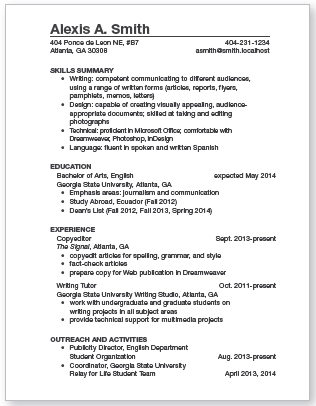MM12: Emphasizing important information
When you look at a document, you’ll notice that some information is emphasized, or treated more prominently, to catch the reader’s attention or communicate a main idea. In print documents, emphasis is usually achieved by the placement of information on the page. Take a look at the sample documents, a résumé and a brochure, in Figures 12-1 and 12-2. What information jumps out at you? What information do you think is the most important in each one?
When you examine the résumé, think about the context and purpose of a résumé. The “work” a résumé does is to “sell” the author—to best portray his or her abilities, skills, and experiences. In this example, the author emphasizes her name with large, boldface type. She presents categories that will be of interest to her reader in a consistent way. The second document, a brochure, would appear folded, with the panel on the right as the “cover.” The emphasis is on a photograph of a puppy and a child. Why? The composer made choices to inspire the reader to act on behalf of the family pet.
Composers use different methods of emphasizing important information, depending on the type of composition they’re producing. If you have written traditional essays, you may be used to creating emphasis with your words and sentence structure—using phrases like “and most important” or “the strongest evidence yet.” In traditional essays, information is expressed in written words, and your readers need to be able to discern what information is critical without the aid of visual cues. When you compose multimodal essays, you’ll have to first determine what information is most important to emphasize, given your purpose and audience, and then how you can best emphasize that information, given your genre and modes.

